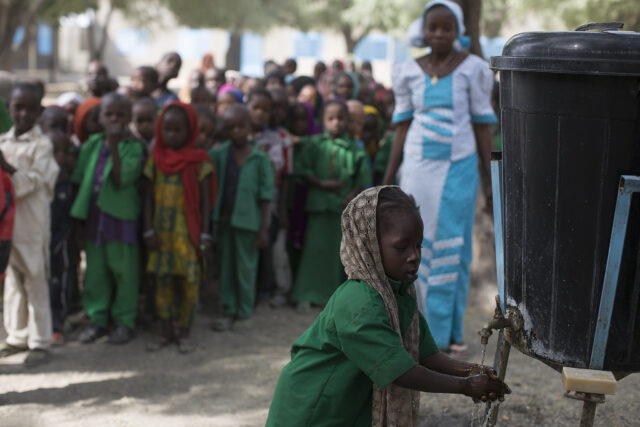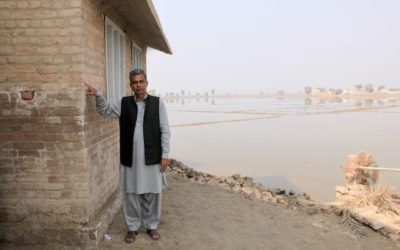Interview: Climate, conflict and displacement around Lake Chad
Image: the shores of Lake Chad. EU Civil Protection and Humanitarian Aid. (CC BY-NC-ND 2.0)
Interview: Climate, conflict and displacement around Lake Chad
Image: the shores of Lake Chad. EU Civil Protection and Humanitarian Aid. (CC BY-NC-ND 2.0)
Interview: Amali Tower, Climate Refugees
We spoke to Amali Tower of Climate Refugees about her work around Lake Chad and the ways climate change has exacerbated conflict in the region.
UPDATE: Climate Refugees has just released the report Shrinking Options: The Nexus Between Climate Change, Displacement and Security in the Lake Chad Basin.
The report is based on hundreds of interviews with displaced people from the area around Lake Chad. The interviews asked people to reflect on how the shrinking of the lake and climate change had impacted their livelihoods and shaped the armed conflict that had caused their displacement.
We asked Amali to reflect on the findings of the report and the process of conducting the interviews as well as the background to wider work. Below are highlights from the coversation that have been edit for length and clarity.
Alex Randall: You formed Climate Refugees in 2015. Tell us about the motivation behind starting the organisation.
Amali Tower: I come from a refugee protection background with UNHCR. Having been in this field it started to be very clear to me that we have emerging climate threats that will leave people displaced across borders and outside of a legal framework for protection. So I formed the organisation into 2015 really, to build an evidentiary basis to find out whether a) is this happening? And b) what role does that have in either creating, contributing or exacerbating conflict? And then, using that as a basis through which to advocate for legal protection.
Doing this obviously does much to put a human face on climate change. It stops it being something that is nebulous or unseen.
AR: You’ve just released a report looking at the shrinking of Lake Chad and the complex web of connections between climate, human mobility and armed conflict. Why were you drawn to this topic?
AT: When we talk about the conflict around the Lake Chad region it is always in the context of Boko Haram. We talk about food security and the humanitarian situation. But again, it’s always through the lens of conflict with Boko Haram. But I was curious to understand the role that the lake shrinking had played. Does the lake shrinking contribute to that conflict? And it turns out, it very much does.
So that’s what took us to Lake Chad. To shed some light on what is a prime example of a conflict that is exacerbated by climate change.
Image: “Nigerians massively fled across the border with Niger when insurgents of Boko Haram attacked their town, Damassak, on 24 November 2014. The makeshift camp op Gagamari in Diffa region counts 16,000 refugees. Following a string of attacks along the border, the government of Niger has declared a humanitarian emergency and asked organisations for help in setting up camps. The violence in North-east Nigeria has resulted in the displacement of 150,000 people to neighbouring countries – a majority of which are in Niger – and over 1.5 million people in Nigeria itself.”
Kri Kri, on the shores of Lake Chad. EU Civil Protection and Humanitarian Aid (CC BY-NC-ND 2.0)

AR: The basis of the report is a series of interviews you conducted with people around Lake Chad. When you spoke to people in the area and people who’d been affected by the conflict, how did they describe the role of climate change in the situation?
AT: I was incredibly surprised how often it was articulated. Sometimes directly, sometimes indirectly. But I did hear – across the board – that climate change played a really huge role.
The Lake Chad area is highly marginalised. It’s excluded from the political centre of all four countries that surround it. There is this record of underdevelopment and political marginalisation. There’s a lack of roads, a lack of education, a lack of alternative means of development. That means if you’re dependent upon the lake, and if the lake is shrinking, well, then there are no alternatives.
You have those two negative forces of underdevelopment and climate change. And when those two forces come together they really make the whole region incredibly vulnerable to exploitation.
So what you have is Boko Haram starting an uprising in Northern Nigeria. And that is rooted in economic disparity, unequal access to services, in disenfranchisement. That created the perfect recipe for the displacement of residents around lake Chad.
AR: When you asked displaced people from the region how the shrinking of the lake had contributed to the conflict and their displacement – what responses did you hear?
AT: I asked people whether climate change had impacted them in terms of the conflict with Boko Haram. They pointedly told me “Yes, absolutely”. So I asked “Ok, well how did that happen?”.
Displaced people I spoke to in Nigeria told me that the shrinking of the lake had opened up access to land for Boko Haram. Before the shrinking of the lake there had been a natural barrier. The lake would have protected them and prevented anyone from raiding their villages. So that was the first thing.
The second thing people mentioned was the way the government had pushed Boko Haram into the lake region. This had given them de facto control over some of the area around the lake. What was left of the lake then became an economic livelihood for Boko Haram.
Many people described “chasing the water”. As the lake receded they had to move closer to the source of water. This had many adverse impacts on their lives. But it also bought them into contact with Boko Haram.
Image: “Lake Chad Bassin crisis january 2017. A major humanitarian crisis continues to grip Africa’s Lake Chad basin, where violence and destruction have caused huge population displacements, left hundreds of thousands of children trapped behind conflict lines and led to a dramatic increase in malnutrition. Boko Haram’s attacks and military operations have displaced 2.4 million people across north-eastern Nigeria, Cameroon’s Far North, south-east Niger and western Chad.
Photo: Espen Røst, Bistandsaktuelt / The Norwegian Ministry of Foreign Affairs. (CC BY-NC-ND 2.0)

AR: Were you surprised to hear these connections to climate change being made by the people you spoke to?
AT: I approached the interviews from a standpoint of asking “What was the impetus that forced you to flee?” Now, that’s a really difficult question to ask without leading the conversation. It’s a difficult question to ask when you’re trying to understand whether an external factor like climate change played a role.
But I was completely floored. I interviewed 105 refugees. I had a particular focus group where people were incredibly analytical about climate change and how it threatened conflict. And in their case how climate change had exacerbated conflict and led to their actual displacement.
People saw the lake full then diminish, full, diminish, full again, diminished. So there’s no denying it. People around the lake had a visual representation of climate change. So I do think there was a sophisticated awareness of climate change there.
Download the report:
Shrinking Options: The Nexus Between Climate Change, Displacement and Security in the Lake Chad Basin.
Climate change and migration: predictions, politics and policy
Get to grips with one of the defining issues of the 21st Century – how will climate change re-shape migration across the world. Join a free, 100% online course to investigate this essential topic
Event: Migration and displacement at the climate talks
How are migration and displacement being dealt with at the international climate change talks? Find out more with our online event
Event: Climate change and Migration 101. 4 December
Get to grips with the links between climate and the movement of people
Event: hot wars- Climate change, armed conflict and security. 15 November
What do we know about the links between climate change and conflict? Will life on a hotter planet be on with more armed violence?
Briefing: climate change and migration. 24 October, London
An evening briefing exploring the links between climate change and migration. Find out more and book places. 24 October, London
Workshop on climate change and migration. 16 October, London
Workshop on climate change and migration. A half-day session exploring the links between climate change and migration. 16 October, London






